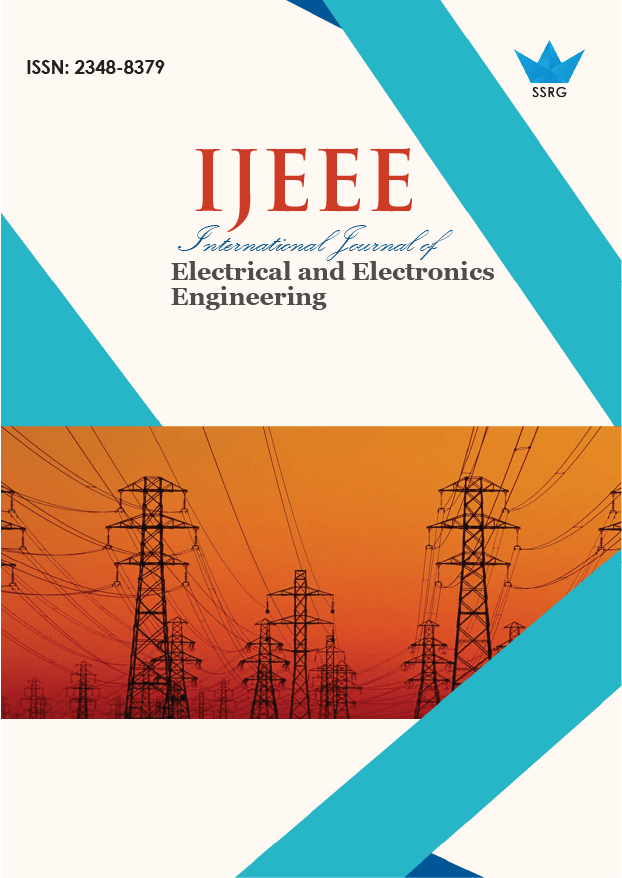Design of a Low-Cost Wireless Power and Data Communication System for a Small-Scale Vacuum Oven

| International Journal of Electrical and Electronics Engineering |
| © 2025 by SSRG - IJEEE Journal |
| Volume 12 Issue 9 |
| Year of Publication : 2025 |
| Authors : Franz De la Cruz, Josue Tinoco, Patrick Cuyubamba, Francis Tinoco |
How to Cite?
Franz De la Cruz, Josue Tinoco, Patrick Cuyubamba, Francis Tinoco, "Design of a Low-Cost Wireless Power and Data Communication System for a Small-Scale Vacuum Oven," SSRG International Journal of Electrical and Electronics Engineering, vol. 12, no. 9, pp. 29-37, 2025. Crossref, https://doi.org/10.14445/23488379/IJEEE-V12I9P104
Abstract:
Vacuum drying is an effective method for food preservation that maintains high product quality, but its adoption is limited by the high cost of commercial equipment and the engineering challenges of creating reliable vacuum seals around wired components. This study presents the systematic design of a low-cost, wireless-powered vacuum oven that eliminates the need for physical wire feedthroughs. Following the VDI 2221 design guideline, several design concepts were developed and evaluated using a technical value analysis to select the optimal solution. The selected design features a fully contactless system, employing inductive Wireless Power Transfer (WPT) for internal electronics and bidirectional radio frequency communication for data transfer. A power budget analysis showed that the WPT system can deliver 22.5 W to the internal components, far exceeding their estimated maximum demand of 1.65 W. Furthermore, a cost analysis of the essential electronic components resulted in an estimated total of approximately $158 USD. The results demonstrate that the proposed design has a significant power safety margin and is economically feasible.
Keywords:
Wireless Power Transmission (WPT), Wireless Sensor Networks, Vacuum oven, Small-scale.
References:
[1] Dayuan Wang et al., “Novel Drying Techniques for Controlling Microbial Contamination in Fresh Food: A Review,” Drying Technology, vol. 41, no. 2, pp. 172-189, 2022.
[CrossRef] [Google Scholar] [Publisher Link]
[2] Nupur Nandan Nagwekar, Vaibhav Baburao Tidke, and Bhaskar Narayan Thorat, “Seasonal Nutritional Food Security to Indian Women through Community-Level Implementation of Domestic Solar Conduction Dryer,” Ecology of Food and Nutrition, vol. 59, no. 5, pp. 525-551, 2020.
[CrossRef] [Google Scholar] [Publisher Link]
[3] S. Madhankumar et al., “Design and Modelling of Automated Hot Oven Food Dehydrator,” 2021 7th International Conference on Advanced Computing and Communication Systems (ICACCS), Coimbatore, India, pp. 1130-1134, 2021.
[CrossRef] [Google Scholar] [Publisher Link]
[4] Abdullah Wagiman et al., “Design and Performance Evaluation of Hybrid Photovoltaic Thermal Solar Dehydrator,” Journal of Advanced Research in Applied Sciences and Engineering Technology, vol. 28, no. 2, pp. 181-189, 2022.
[CrossRef] [Google Scholar] [Publisher Link]
[5] Pedro Quiñones-Reyes et al., “Networked Control System for a Hybrid Dehydrator from the Design of Experiments,” 2019 IEEE International Fall Meeting on Communications and Computing (ROC&C), Acapulco, Mexico, pp. 34-39, 2019.
[CrossRef] [Google Scholar] [Publisher Link]
[6] Mohammad Zarein, Seyed Hashem Samadi, and Barat Ghobadian, “Investigation of Microwave Dryer Effect on Energy Efficiency During Drying of Apple Slices,” Journal of the Saudi Society of Agricultural Sciences, vol. 14, no. 1, pp. 41-47, 2015.
[CrossRef] [Google Scholar] [Publisher Link]
[7] Arif Rahman Hakim, Wahyu Tri Handoyo, and Adrianto Widi Prasetya, “Design and Performance of Scaled-Up Microwave Dryer for Seaweed Drying,” Squalen Bulletin of Marine and Fisheries Postharvest and Biotechnology, vol. 15, no. 3, pp. 141-152, 2020.
[CrossRef] [Google Scholar] [Publisher Link]
[8] Lukas Kano Mangalla et al., “Experimental Study on the Performance Characteristics of a Microwave-Solar Heating Dryer,” IOP Conference Series: Materials Science and Engineering, vol. 797, no. 1, pp. 1-6, 2020.
[CrossRef] [Google Scholar] [Publisher Link]
[9] Amin Hazervazifeh, Ali M. Nikbakht, and Shahriar Nazari, “Industrial Microwave Dryer an Effective Design to Reduce Non-Uniform Heating,” Engineering in Agriculture, Environment and Food, vol. 14, no. 4, pp. 110-121, 2021.
[CrossRef] [Google Scholar] [Publisher Link]
[10] Mukda Bowornprasittikun et al., “Induction Food Dehydrator with Temperature Control,” 2019 7th International Electrical Engineering Congress (iEECON), Hua Hin, Thailand, pp. 1-4, 2019.
[CrossRef] [Google Scholar] [Publisher Link]
[11] Sagar Bhatta, Tatjana Stevanovic Janezic, and Cristina Ratti, “Freeze-Drying of Plant-Based Foods,” Foods, vol. 9, no. 1, pp. 1-22, 2020.
[CrossRef] [Google Scholar] [Publisher Link]
[12] Thayla B. Roratto et al., “An Innovative Hybrid-Solar-Vacuum Dryer to Produce High-Quality Dried Fruits and Vegetables,” LWT, vol. 140, 2021.
[CrossRef] [Google Scholar] [Publisher Link]
[13] Linh Thuy Khanh Do et al., “Mathematical Modeling and Optimization of Low-Temperature Vacuum Drying for Banana,” Carpathian Journal of Food Science and Technology, vol. 13, no. 4, pp. 47-61, 2021.
[CrossRef] [Google Scholar] [Publisher Link]
[14] Benjamin R. Hubbard et al., “Open Source Vacuum Oven Design for Low-Temperature Drying: Performance Evaluation for Recycled PET and Biomass,” Journal of Manufacturing and Materials Processing, vol. 5, no. 2, pp. 1-35, 2021.
[CrossRef] [Google Scholar] [Publisher Link]
[15] Oscar Lucía et al., “Induction Heating Technology and its Applications: Past Developments, Current Technology, and Future Challenges,” IEEE Transactions on Industrial Electronics, vol. 61, no. 5, pp. 2509-2520, 2014.
[CrossRef] [Google Scholar] [Publisher Link]
[16] J. Jänsch, and H. Birkhofer, “The Development of the Guideline VDI 2221-the Change of Direction,” DS 36: Proceedings DESIGN 2006, the 9th International Design Conference, Dubrovnik, Croatia, pp. 45-52, 2006.
[Google Scholar] [Publisher Link]
[17] Wolfgang Ernst Eder, “Theory of Technical Systems-Educational Tool for Engineering,” Universal Journal of Educational Research, vol. 4, no. 6, pp. 1395-1405, 2016.
[CrossRef] [Google Scholar] [Publisher Link]
[18] Consistent Performance, at a High Degree: Thermo Scientific Vacuum Ovens, Thermo Fisher Scientific Inc, pp. 1-16, 2017. [Online]. Available:
https://assets.thermofisher.com/TFS-Assets/LED/brochures/Vacuum%20Ovens%20Portfolio%20Brochure_FINAL_Aug2017.pdf

 10.14445/23488379/IJEEE-V12I9P104
10.14445/23488379/IJEEE-V12I9P104